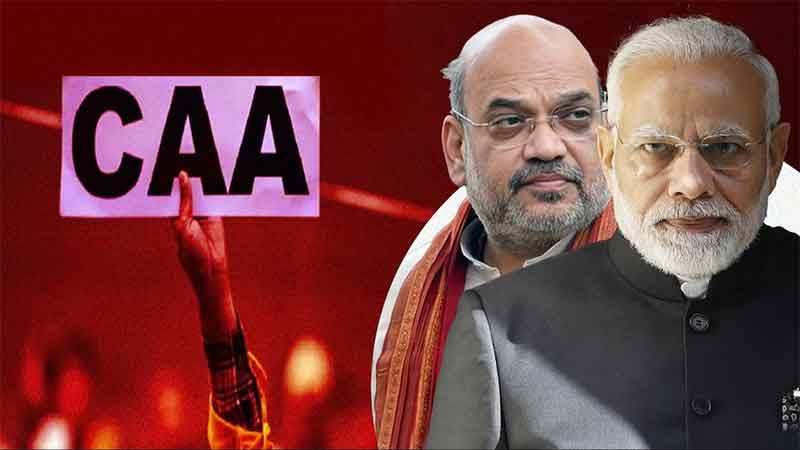
After its passing on the 11 December 2019, the contentious Citizenship Amendment Act (CAA), providing pathway to Indian citizenship for refugees from the neighbouring countries on the basis of the religion they belong to, had caused large-scale protests all over India. The news in the initial few month’s period of 2020 was rife with citizens on the street voicing their reluctance against the Act. With the pandemic outbreak of COVID 19, these protests and discussions have been deadened as of 24 March. After lying dormant for a long time, the protests have again started burgeoning in the country against the act.
Gloria Steinem, a spokesperson and social activist for the American feminist liberation movement in the late 1960s once said, “No one can give us power. If we aren’t part of the process of taking it, we won’t be strong enough to use it”. The current Anti-CAA movement of India draws from similar motivations, as it has given the opportunity to the young Muslim women to spearhead the protests. It has been a novel movement for a patriarch society like ours, where women are bound by a lot of gender-based stereotypes. Instead of being docile and submissive, their perception has shifted towards a more assertive image. Women from all parts of life has joined all around the country like Safoora Zargar, a student of Jamia Millia Islamia University in Delhi to Nausheen Baba Khan in Park Circus, Kolkata.
With such a context, we were fortunate to have a discussion with two of these women – Sadaf Jafar and Naheed Aqueel – to get a glimpse of the Anti-CAA movement of Lucknow, including the infamous 19th December events, where protests turned violent.
Sadaf is a social activist, a history and political science teacher for around 15 years associated with the Congress party, holding a belief that one can’t be a teacher until one is an activist. She has worked on social activism on sensitive issues such as domestic violence and women empowerment. Her peaceful protests against CAA were obstructed on December 19th leading to her arrest, where other protestors and children were beaten up. She was allegedly kept hungry and thirsty for 34 hours, while her hair was pulled and her back was bruised in the jail. Even though she was in the lock-up for 20 days, her only takeaway from the experience was the support in the form of female camaraderie that she received for her troubles.
Naheed, whose grandfather was a freedom fighter, has been a social worker for the last 15 years, where she has worked on grass root problems such as rural issues, poverty and backward Dalit issues. Her contributions for the Muslim Backward Dalit families, the Pashmanda and single women has received notable awards from the Governor and CMs of Uttar Pradesh. She was one of the 6 women to receive Niti Ayog’s Women Transforming India Awards 2016. Usually in a patriarchal society like ours, where a women’s identity is defined by her husband, Naheed’s Akel Mahila Manch is a sign of respite as it provides voice to a 3-crore single women community of our country. During 19th December, she protested with her small procession of 7-8 women against the act. Some pictures of the protest were posted on Facebook, creating a snowball effect which garnered later, a lot of support from the masses.
According to Naheed, the whole message of the movement was twisted to a Hindu vs Muslim movement, where Naheed’s religion discouraged the participation of other communities. Both the experiences of the two women leading the protests were similar in some respect. Firstly, the movement was initially planned as a peaceful protest to show the disagreement towards the act, but it eventually became a violent and chaotic procession. Sadaf wanted to lead the protest in a no slogan, no anti-authority way. But a bunch of hooligans, who didn’t belong to the protests started making it violent, which provided the Police an opportunity to retaliate hard. These hooligans rendered Namaz in the middle of such chaos, creating a misnomer of the actual message of the protests. For Naheed similar factions, who were not part of the initial peaceful processions, created violence and chaos. Naheed recounts the day vividly, as she saw a Muslim autorickshaw driver, who went to collect groceries due to the haste of the protests, gunned from the front direction as a collateral. Such politicisation of events was used as a pivot for polarising the two religions, which diluted the main purpose.
Secondly, police brutality was considered as a substantial challenge of organising such movements. While a lot of Indian celebrities have focused and showed their disagreement with the police brutality on the George Floyd case in the Black Lives Matter movement, our own citizens suffer from a similar treatment by the police and no voices are raised for that. Police was called for curbing the violence and chaos spread in such protests, where they instigated the opposite through Lathi charges.
One good takeaway from the protests was the use of social media sites like WhatsApp and Facebook, which enabled huge participation of citizens in these movements. These sites informed the citizens about the atrocities happening around the country in these movements, and connected all of them. But we should also understand that the democratisation of media leads to bad consequences and misinformation as well. Such information asymmetry is created as our news has been commoditised, where spiced-up versions are sought after. Our houses are served with the news attuned to our likings, helping in creating an extremely biased position on any issue. Conveying a lucid message to the supporters is the biggest hurdle faced by the current protests, where dilution of message is happening heavily.
But such protests have given a proper platform to the empowerment struggle of women in our country. As mentioned by Naheed, the protests have enhanced the personal development of women, as they are learning to raise their voices and mobilise supporters. These young women will be the future leaders for the new India. Such optimism is certainly a step forward for our society, but how much of these enhancements will be carried forward into the women’s own homes, still needs to be seen?
Sadaf considers Bhagat Singh of freedom movement as the motivation for her protests. Overall, it’s really saddening to see activists like her compare our current India of 2020, to a Nazi Germany, were cleansing happened according to the ethnic group a citizen belonged to, or to the freedom movements of India, as we are, after all– a democracy. We are a secular country, where children take pledges every morning by saying “All Indians are my brothers and sisters”. The Act and its supporters show the subtle exploitative system running in our country, where we feed on the marginalised.
Subham Majumder is a PGP-2 student at IIM Ahmedabad
SIGN UP FOR COUNTERCURRENTS DAILY NEWSLETTER















































